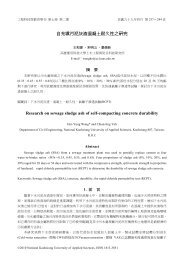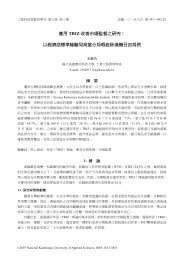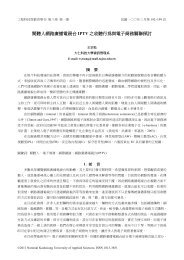線性非時變系統之即時參數估測 - 高雄應用科技大學
線性非時變系統之即時參數估測 - 高雄應用科技大學
線性非時變系統之即時參數估測 - 高雄應用科技大學
You also want an ePaper? Increase the reach of your titles
YUMPU automatically turns print PDFs into web optimized ePapers that Google loves.
線 性 非 時 變 系 統 之 即 時 參 數 估 測 341參 考 文 獻[1] Ziegler, J. G. and Nichols, N. B. “Optimum settings for automatic controllers,” Trans. ASME, Vol. 64, pp. 759-768, 1942.[2] 蘇 乾 元 、 余 政 靖 ,“PID 控 制 : 現 狀 、 功 能 及 調 諧 ”, 化 工 ,Vol. 55, pp. 3-17, 2008.[3] Ang, K. H. and Chong, G. “PID Control System Analysis, Design, and Technology,” IEEE Transactions On ControlSystem Technology, pp. 3-6, Vol. 13, 2005.[4] O'Dwyer, A. Handbook of PI and PID controller tuning rules, 2nd ed., London: Imperial College Press, 2006.[5] Smith, C. L., Digital Computer Process Control, Intext Educational Publishers: Scranton, PA, 1972.[6] Sundaresan, K. R. and Krishnaswamy, R. R., “Estimation of time delay, time constant parameters in time, frequency, andLaplace domains,” Can. J. Chem. Eng., Vol. 56, pp. 257, 1978.[7] Rangaiah, G. P. and Krishnaswamy, P. R., “Estimating second order plus dead time model parameters,” Ind. Eng. Chem.Res., Vol. 33, pp. 1867-1871, 1994.[8] Åström, K. J. and Hägglund, T., “Automatic tuning of simple controller with specification on phase and amplitudemargins,” Automatica, Vol. 20, pp. 645–651, 1984.[9] Shen, S.-H., Yu, H.-D. and Yu, C.-C., “Autotune identification for systems with right-half-plane poles and zeros,” Journalof Process Control, Vol. 9, pp. 161-169, 1999.[10] Liu, T., Gao, F., and Wang, Y., “A systematic approach for on-line identification of second-order process model from relayfeedback test,” AIChE J., Vol. 54, pp. 1560-1578, 2008.[11] Yuwana, M., and Seborg, D. E., “A method for on-line controller tuning,” AIChE J., Vol. 28, pp. 434-440, 1982.[12] Jutan, A. and Rodriguez, II. E. S., “Extension of a new method for on-line controller tuning,” Can. J. Chem. Eng., Vol. 62,pp. 802-807, 1984.[13] Lee, J., Cho, W., and Edgar, T. F., “An improved technique for PID controller tuning from closed loop tests,” AIChE J.,Vol. 36, pp. 1891-1895, 1990.[14] Chen, C. L., “A simple method for on-line identification and controller tuning,” AIChE J., Vol. 35, pp. 2037-2039, 1989.[15] Mamat, R. and Fleming, P. J., “Method for on-line identification of a first order plus dead-time process model,”Electronics Letters, Vol. 31, pp. 1297-1298, 1995.[16] Ananth, I. and Chidambaram, M., “Closed-loop identification of transfer function model for unstable systems,” Journal ofthe Franklin Institute, Vol. 336, pp. 1055-1061, 1999.[17] Cheres, E., “Parameter estimation of an unstable system with a PID controller in a closed loop configuration,” Journal ofthe Franklin Institute, Vol. 343, pp. 204-209, 2006.[18] Sree, R. Padma and Chidambaram, M., “Improved closed loop identification of transfer function model for unstablesystems,” Journal of the Franklin Institute, Vol. 343, pp. 152-160, 2006.[19] Åström, K. J. and Wittenmark, B., Adaptive Control, Addison Wesley, 1989.[20] Crisalle, O. D., Soper, R. A., Mellichamp, D. A., and Seborg, D. E., “Adaptive Control of Photolithography,” AIChE J.,Vol. 38, pp. 1-14, 1992.
















